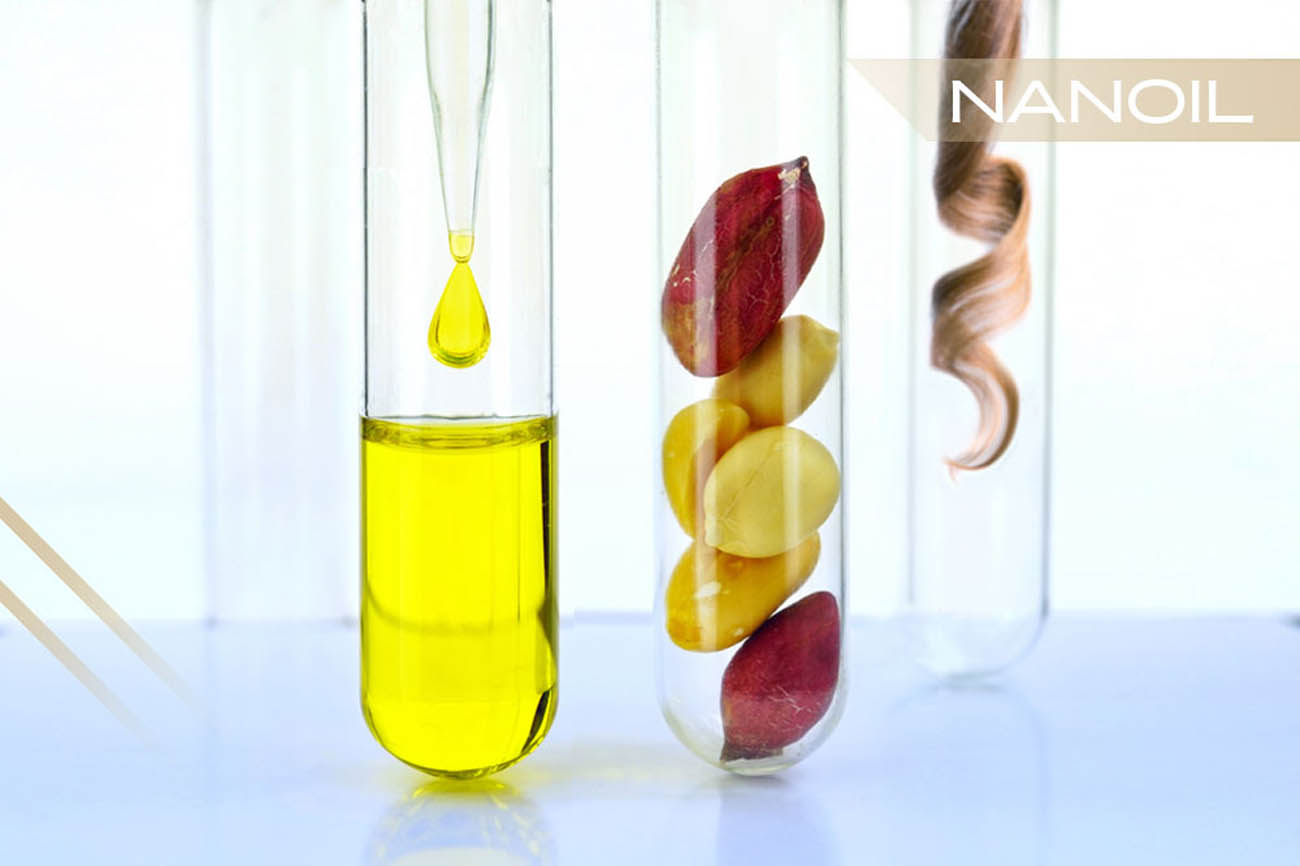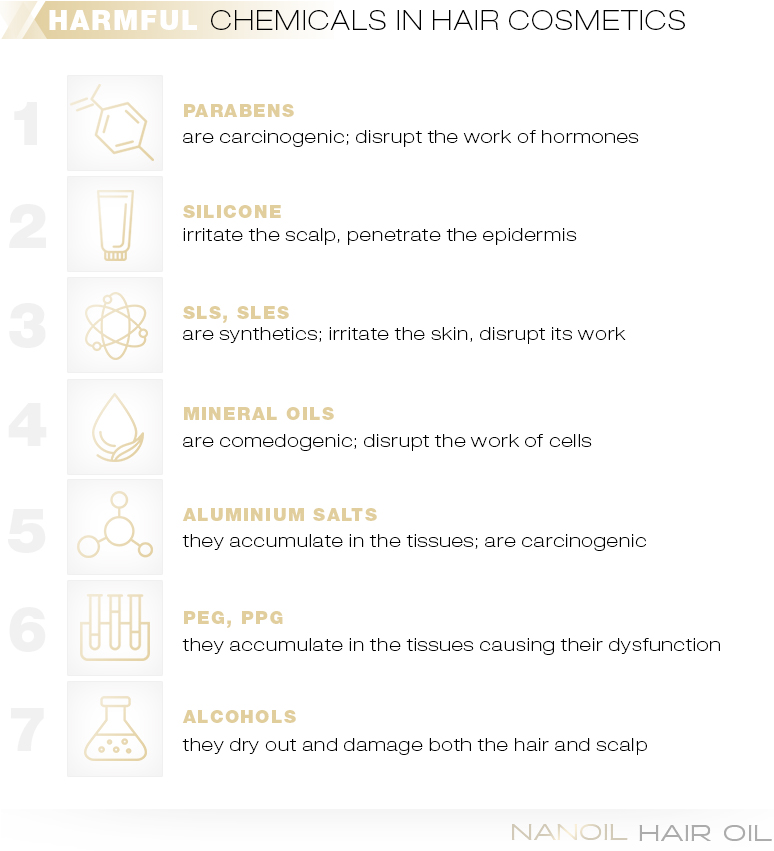- NANOIL Products
- Oils
- Face serums
- Hair masks
- Shampoos
- Hair conditioners
- Hair styling
- Hair Porosity Test
- Blog
- Contact

Preservatives and capping agents have been used in production of cosmetics for dozens of years now. Significantly high concentration of these substances was noticed mainly in shampoos and hair conditioners. So far, there hasn’t been told much about the adverse effects they produce. At present, most cosmetic brands resign from using the very substances in their products and try to replace all hazardous agents with their natural equivalents. Why parabens, silicones and other controversial substances are slowly, yet gradually and systematically, disappearing from hair care products? Can they really cause damage to hair, and if they can, how do they do that?

What are parabens?
These are preservatives added to cosmetics in order to preserve fresh attributes and nutritional quality of shampoos and conditioners. Parabens are frequently used in cosmetics because they neither influence nor alter action delivered by particular beauty products so, in other words, they don't have any impact on the product’s effectiveness. Moreover, preservatives achieved their popularity thanks to their power to delay multiplication of micro-organisms that gather on our skin. Also, the talked-about substances protect cosmetics from all possible microbes.
Are parabens harmful?
It's worth remembering that parabens don't cause allergic reactions and are well-tolerated by skin. Yet, in big amounts they can be, unfortunately, very damaging; they are considered as cancerogenic agents that disturb hormone balance (i.e. encourage oestrogen production). The most popular and the most commonly used parabens in shampoos are, among others, Phenoxyethanol, Methylparaben, Ethylparaben, Propylparaben, Butylparaben, Isobutylparaben - each of them has different 'damage threshold' and doesn't display action potentially harmful for human health providing that its concentration in a particular cosmetic is appropriately low. However, it's worth realizing that we frequently use more than just one product featuring parabens - the dosages of the very substances delivered to organism increase, so does the toxic action, which also sums up. For that reason, while choosing a cosmetic to treat our bodies with, it's worth limiting the quantity of parabens delivered with it, if possible. This applies mainly to the cosmetics which are directly put on the scalp. For that reason, shampoos and oils should lack parabens completely. The most harmful compounds which should be recalled from hair care products are Formaldehyde and Polyacrylamide. Their action is recognised as toxic and the substances, in general, are cancerogenic therefore they should be purposefully avoided.
How to avoid parabens?
The sad truth is that it isn't possible to exclude parabens form hair and body care completely. However, it's worth using them in scarce amounts, or to reach for the products that contain the least harmful type of paraben, which is Methylparaben. Instead of applying synthetic hair masks, it's better to choose oils; a good solution here is offered by precisely developed oil blends featuring natural and high quality ingredients. Again, it's wise to reach for paraben-free shampoos, yet you don't have to follow this rule while selecting a hair conditioner since this cosmetic is applied to the strands only (to the mid-lengths downwards). Since this product isn’t in contact with skin, there is no need in being so rigorous while picking one for yourself. Another point that is often overlooked is that there are other substances recognized as paraben alternatives (substances enabling a cosmetic to preserve its qualities for longer) and these are in particular: vitamin C, vitamin E, essential oils and coconut oil. Obviously, they are always warmly welcomed in composition of a cosmetic.
What are silicones?
This is the most favoured group of substances frequently added to shampoos and hair conditioners. Silicones often appear in lotions, leave-in conditioners, heat protection sprays, they are mixed with oils, conditioners and masks. Moreover, these substances are often called 'silicone oils' because of their greasy and slightly sticky consistency. Created by combining silica and oxygen, they determine consistency of a product and influence the way in which a particular product is distributed either on skin or hair. Actually, silicones are easy to find in many hair cosmetics because their application encourage immediate hair condition improvement; strands become smooth and shiny.
Are silicones harmful?
Silicones might irritate scalp, especially when they are used as an ingredient of hair masks or lotion sprays. Once included into this type of products’ composition, there's a high risk of silicone becoming in contact with skin and penetrating through the cells. It's considered to be markedly better when hair products contain silicones in their volatile form. Considerable amount of them is released into air the moment applied so they don't residue on skin. It's worth realizing that both heavy silicones and non-volatile silicones are as often added into cosmetics as the delicate silicones. Another key point is that silicones don't undergo biological decay process so, what is connected with that, they cumulate in tissues and cells of organism. It's important to realize that many silicone oils irritate skin and are comedogenic. The least health-friendly group of silicones includes heavy silicones. In short, they don't evaporate from surfaces and residue on hair creating a barrier which both the good (needed by hair) and the bad substances can’t go through.
How to avoid silicones?
The best solution is to resign from using the most damaging ones, which have the tendency to irritate scalp along with the delicate ear skin area. This group of silicones is called heavy silicones and includes: Simethicone, Trimethicone, Trimethylsiloxysilicate, Trimethylsilylamodimethicone.
What are SLS, SLES?
SLS (Sodium Lauryl Sulfate) - it's an aggressively working detergent used in various products, which not always connected with hair care.
SLES (Sodium Laureth Sulfate) – akin to the above-mentioned substance that is formed from ethylene oxide. It's a petroleum derivative and has heavy lathering features therefore it is frequently added to shampoos and cleaning products (including household cleaning products).
Are SLS, SLES harmful?
These are synthetic detergents which have adverse, highly irritating influence on skin. To clarify, they can cause itching, acne, spots, eczema and dehydration. It also happens that they are combined with Dioxane known for its cancerogenic features. These detergents are recognized as comedogenic and their particles penetrate through skin getting inside organism.
How to avoid SLS, SLES?
It's suggested to check the list of ingredients of a particular product before buying it. In most cases, you can find the substances under the name of Sodium Lauryl Sulfate and Sodium Laureth Sulfate (INCI).
What are mineral oils?
These aren't the commonly known natural vegetable oils so under no circumstances should they be connected with each other. Mineral oils are all possible petroleum oil derivatives, including paraffin wax, for example. They are made in the process of distillation of crude oil. They appear in cosmetics mainly because of their lipid-replenishing feature so, in other words, they work on skin and hair like emollients. In short, they don’t only stabilize substances but also protect epidermis and strands against water loss. Additionally, they are relatively cheap which makes them so highly appreciated by many cosmetic manufacturers.
Are mineral oils harmful?
Undoubtedly, they are comedogenic so, in plain English, they clog skin pores. Moreover, they can build up on skin's surface and create a kind of impermeable coat, an occlusive layer which impedes gas exchange of skin cells. To clarify, this coat blocks oxygen and 'suffocates' skin cells decreasing their efficiency and worsening their action. Also, there has been no-one yet to demolish the myth stating that mineral oils gather in kidneys and liver.
How to avoid mineral oils?
Mineral oils, mostly paraffin wax and petroleum jelly, ought to be completely eliminated, yet they shouldn’t do much harm when used in small, reasonable amounts. In order to avoid mineral oils in cosmetics, it's advised to reach for the beauty products which contain other, natural and safe emollients and these include natural oils and vegetable butters. It's worth realizing that paraffin wax included in cosmetics can be found as Paraffin (oil), Synthetic Wax, Isoparaffin, Parrafinum Liquidum. Other mineral oils which can be approached while reading labels of hair products are: Petrolatum (vaseline), Ceresin, Isobutane, Isopropan.
What are aluminium salts?
Aluminium, also known as aluminum, is the most frequently used ingredient included in cosmetics aiming in balancing (or to be more precise, blocking) sebum and sweat secretion.
Are aluminium salts harmful?
You ca find aluminium salts mostly in deodorants, hair sprays and some dry shampoos. They clog skin pores which impedes sweating and sebum production. However, these substances cumulate in tissues, simultaneously irritating the immune system; aluminium salts are able to penetrate and harm other systems, too. It's important to realize that there are evidences linking antiperspirant use with malignant breast tumour development.
How to avoid aluminium salts?
The most common form of aluminium salt added into cosmetics is labelled as Aluminum Chlorohydrate. Other pathogenetic substances are Aluminium Chlorohydrate (ACH) and Aluminium–Zirconium (Aluminium Zirconium Tetrachlorohydrex GLY). In other words, the easiest way to avoid aluminium salts is being cautious and paying attention to the 'aluminium' word which appears frequently in the beginning of a particular substance that the list of ingredients features.
What are PEG, PPG?
Simply, these are Polyethylene Glycols. In cosmetic products they are used in the role of emulsifying agents, solvents and all possible kinds of substances responsible for increasing tenacity of a cosmetic. It's worth mentioning that Ethylene Oxide and cancerogenic Dioxanes are used during the production process of PEG and PPG.
Are PEG, PPG harmful?
They can be harmful if used in galore. Actually, they are known for gradually cumulating in organism through years, residing in cells and organs. As it is not hard to guess, the less of them in a cosmetic, the better. The truth is, their harmfulness is determined by the toxic substances that are needed to be used in glycol production process.
How to avoid PEG, PPG?
Most frequently used glycols of PEG and PPG types are very easy to recognize, luckily. Generally, they feature 'PEG/PPG' prefix like, for example, PEG-40 Sorbitan Disostearate, PPG-15 Stearate, or '-eth' suffix such as Laureth-8-Phosphate.
What are alcohols?
Alcohols create a very large group when it comes to substances used in hair and body cosmetics. The good news is that we can find dozens of alcohols which deliver positive action to hair and scalp. To clarify, they are known for being able to moisturise and condition strands, simultaneously being an important agent bonding emulsion. This very type of alcohols are the ones that belong to polyhydroxy, dihydroxy and long-chained alcohol groups. They create a protective coat on hair's surface and gift strands with softness. The most popular 'good' alcohol is glycerine.
Are alcohols harmful?
Unfortunately, there is a group of 'bad' alcohols existing which deliver a highly dehydrating action. They don’t only damage hair but can also cause scalp allergies. These are all monohydroxy group alcohols. In short, they deliver a very negative action to hair since these alcohols make strands significantly weaker, deprive them of shine and elasticity.
How to avoid alcohols?
Certainly, you don't need to avoid these 'good' alcohols. Instead, learn how to find the harmful alcohols which contribute to worsening hair condition. For example, these are: Alcohol Denat/SD Alcohol, Benzyl Alcohol, Ethanol Alcohol, Grain Alcohol, Isopropanol Alcohol, Iisopropyl Alcohol (IPA) and Propanol Alcohol, to name just a few.
Where paraben-free and silicone-free cosmetics can be found?
There is a list of cosmetics that, because of the character and purpose they serve, are deprived of harmful, comedogenic and irritating substances. For example, these the following products:
Leave your email address and we ll notify you when the product is back in stock.
Comments: #0